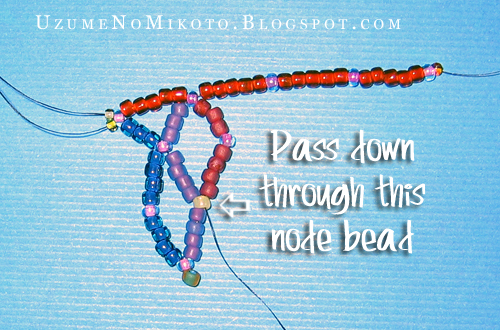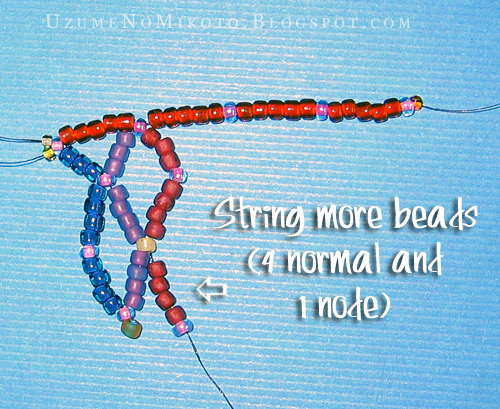I am pleased to present the latest in what is rapidly becoming a series of tutorials on the basic beadweaving stitches:
Just like with peyote and right angle weave, netting is a versatile stitch that seems complicated but is actually quite simple. It's a good stitch to have under your belt, and even the simplest version can be used to create a pretty lacy collar or a sparkly bead-draped Christmas ornament.
So: on to the tutorial!
You will need:
Beads (I use size 8 seed beads in the tutorial, but I usually use size 11 seed beads)
A needle
Thread
Most netting is done with one foundation row of strung beads, and then a woven net of beads that hangs off of the foundation row. Let's start by making the foundation row. You don't need all that much thread for this, as we'll be using a different piece of thread for the netting.
Foundation Row
As per usual, start by threading one seed bead and passing through it again to make a stop (or 'tension') bead.
Stop bead in place, string some beads. In this case, I'm stringing 25 beads.
The red beads are the 'normal' beads, and the bright purple ones are what I call "node beads". These beads create the structure of the netting, and you'll need to pass through them again at some point in the future. In order to save time, confusion, and bead-counting, I often make my node beads a different color than the normal beads (which looks pretty, so it all works out!).
Once you have your beads strung, add another stop bead on the other side. You're done with the foundation row!
First Column
OK, now is when you need to get out the yardstick to measure your thread... I kid, I kid, but you should cut off a substantially longer piece for the actual netting. Put a stop bead on the end of this new bit of thread.
Pass through the first node bead, going from the left to right.
Here's where the netting actually starts! Add some beads-- in this case, I'm adding 14 beads. The node beads tell me where I'm going to need to pass through again in the future.
OK, now string on one 'end' bead. You can use a normal seed bead for this, or a drop, a dagger, or anything else you feel like trying. Once you've strung your end bead, pass back up through the last node bead.
Second Column
Add some more beads: in this case, I added 9 beads: 4 normal, one node, and 4 more normal.
Here's where color-coding the nodes comes in handy. Pass up through the indicated node (the very first node you strung on this new thread).
String some more beads: in this case, I strung 3 (all normal).
Now, pass through (from left to right) the second node in the foundation string.
You're done with the first part of the net!
Let's start the second part.
Third Column
Add some more beads ( 3 normal, one node, and 4 normal).
Pass downwards through the indicated node (the only node we added on our trip back up from the end bead).
Great! Now to create the second point. Add 4 more normal beads and one more node bead (5 beads in all).
Add another end bead, and, just like the previous end, pass back up through the last node bead you strung.
Fourth Column
Now we need to go back up to the foundation string. Add some more beads: I added 9 (4 normal, 1 node, 4 normal).
Pass upwards through the topmost node in the previous line (as shown).
Almost at the foundation row! Add three more (normal) beads...
And then pass (from left to right) through the third node bead in the foundation line.
And that's all there is to it! To add to your netting, just repeat Column Three and Column Four over and over again.
Here's the path the thread takes. As you can see, it's pretty much a downwards-upwards movement (like a complicated peyote stitch) without any of the circular motion of right angle weave. The first time I saw netting I was positive it was worked in rows-- but, nope, it's done with columns! Neat, huh?
You can vary netting to create all sorts of cool things. If you use fewer beads between the nodes on the foundation row, the piece curves (you'd want to do that to create a collar).
Change the number of beads you use between the nodes to create looser or tighter netting. Play around and see what works for you!
Also, you can use different sorts of beads for the end nodes. I tried pearls: bicones would work well, too, as would spherical beads.
You can use different beads (or miniature pieces of beadwork) as end beads: the stars on the bottom piece actually use the netting technique within them, too!
Try using different types of beads (bicones, etc) as node beads throughout the work.
If you want to, you can even take the foundation row out once you're done-- that'll give you a very different look!
Netting is a very common way to jazz up a plain Christmas ornament, or a lamp or other decorative object. Tie the foundation row into a loop around the neck of the object and net all the way around the circle! Try using different amounts of beads in each portion of the net until your netting hangs well on the ornament/lamp/other object.























This is so pretty!! Very creative, and thank you very much for the very easy and understandable tutoral! This couldd also be made into a necklace, a choker or something, or even a bracelet!
ReplyDelete-The Creative Muslimah
You're welcome!
ReplyDeleteThat's true: the pearl-studded one above is actually and anklet, and the starry one is a bracelet... er, *will* be a bracelet if I ever get around to finishing it. :)
This is super cute..keep it up with your smart tutorials..good luck...;-)
ReplyDeleteHola!
ReplyDeleteGracias por ese tutorial tan bien explicado. Nunca me imaginé que era tan fácil hacer esos collares. Te mando un abrazo desde Venezuela y que tengas unas felices fiestas.
Thank you! I'm glad you enjoyed the tutorial, and I'll definitely be making more. Let's see, I've gotta do spiral rope and herringbone, then I'll probably move on to advanced tuts. :)
ReplyDeleteIngrid, gracias! Yo te mando un abrazo desde California. :D
A very comprehensive tutorial. Excellent!
ReplyDeleteHey Uzume, I am a beginner in beading, but your tutorial is so simple to understand, that I made 2 necklaces for my litle girls !!! Thanks a lot , Please post more tutorials :)
ReplyDeleteThank you for the tutorial
ReplyDeleteHi Uzume, I tried to make a christmas ornament before with this tecnique but it didnt work. Now i think I know what I did wrong: the thread you`re using is a normal thread right? No nylon? Well, I will try it again:) Thank you very much (if it work, I tell you). Please excuse my bad english, Pat
ReplyDeleteHi Pat,
ReplyDeleteI primarily use beading thread, which is made out of nylon, but it's soft and flexible like normal thread.
This website has some of the threads I use on it:
http://www.eebeads.com/_thread.htm
If you're having problems, make sure you're not pulling the beadwork too tight. And maybe try a different string.
Good luck!
using apple brand thread instead....
ReplyDeleteHola! neceito ayuda por favor!! tengo que hacer una red para un Kokoshnik, que es un tocado ruso cosido a una vincha y no se como descontar para que quede largo en el medio y chiquito a los costados.. alguien me puede ayudar!!
ReplyDeleteDejo un link con una foto del tocado ruso Kokoshnik para que vean la red que tengo que hacer, ojala me puedan ayudar!!
ReplyDeletehttps://es.pinterest.com/pin/404127766533857506/